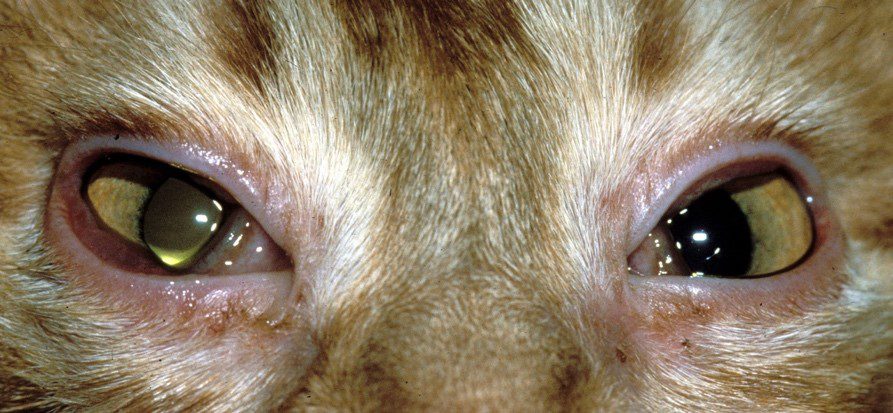Contents
Conjunctivitis in cats: how to treat it?
Red eye, discharge from the eyes, glued eyes? It seems that your cat is suffering from conjunctivitis… This eye disease common in cats is often quickly identified by owners because the signs are easily visible. What to do to relieve and treat the affected cat?
What is conjunctivitis?
Conjunctivitis is an inflammation of a structure in the eye called the conjunctiva. The conjunctiva is the mucous membrane that covers the inside of the eyelids, part of the surface of the eyeball and extends to the inner corner of the eye (the conjunctival cul-de-sac).
Conjunctivitis can affect only one eye or both eyes. It is manifested by the following clinical signs, which will vary in intensity depending on the cause or severity of the disease:
- Redness;
- Partially or completely closed eyelids (sign of eye pain);
- Discharges from the eyes (more or less liquid, light to greenish in color);
- Itching;
- Appearance of the third eyelid (nictitating membrane);
- Eye completely stuck.
Depending on the causes, these signs located in the eyes may be accompanied by other abnormalities:
- respiratory ailment (runny nose, sneezing, etc.);
- decreased appetite;
- abatement;
- fever;
- and others.
What are conjunctivitis due to?
The causes are many and varied: from a simple temporary irritation of the eye to a viral disease to an allergic reaction.
If conjunctivitis affects only one eye, it is often a local reaction. If it affects both eyes, general illness is more likely. But all configurations are possible.
Local irritation or trauma
Contact of the eye with a substance in the environment may be sufficient to create conjunctivitis: it may be a small debris or an irritant to the ocular mucous membranes (which may be a liquid, a solid or a gas).
A foreign body can also slip under the eyelids or in the angle of the eye and cause this local inflammation (think of plant elements such as the famous spikelets).
Infectious causes
Bacteria and viruses are common causes of conjunctivitis in cats. These are then contagious conjunctivitis, transmissible from cat to cat.
Young cats, who have weak immune systems, are particularly susceptible to these types of conjunctivitis. They can create severe forms with purulent discharge, very swollen eyes, glued eyelids. In the most serious cases, some cats lose one or both eyes as a result of the disease.
We can cite the example of Feline Herpesvirus (FHV-1) which causes, in addition to conjunctivitis, significant respiratory ailments. This virus can also latent in the body of the affected cat and reactivate later during periods of stress or fatigue. Correct vaccination can limit or even eliminate infection or signs of the disease.
As another example, Chlamydia felis is a bacterium which causes a very contagious conjunctivitis which spreads easily in the groups of cats living in community.
Other causes
Conjunctivitis can be manifestations of other eye conditions, in particular if they are repetitive or chronic: malformation of the eyelids, glaucoma. Certain systemic pathologies have conjunctivitis as a calling sign: tumor pathologies (lymphoma), dysimmunity or infectious disease (FeLV).
An allergic reaction can also cause a conjunctiva which, depending on the case, can remain unilateral but will often be bilateral and be accompanied by other symptoms more or less extensive on the face or the body.
How to treat conjunctivitis?
If you have the impression that your cat is suffering from conjunctivitis, it is essential to take her to your veterinarian. Given the wide variety of causes of conjunctivitis, it is best to have a veterinarian examine your cat to determine the cause of the conjunctivitis and initiate the appropriate treatment.
Your veterinarian will have to do a careful eye exam, with local tests. It is also possible that additional examinations are necessary (samples, etc.).
For the simplest cases, the treatment involves:
- regular eye cleaning;
- eye drops in the form of drops and ointment to put in the eyes several times a day (antibiotic, anti-infective, etc.);
- if necessary, a collar to prevent the scratching cat from hurting itself can be put in place;
- oral treatment may be prescribed in some cases.
If the cat is severely ill with general illness, hospitalization may be necessary.
Conclusion
Despite their benign appearance, conjunctivitis are pathologies that require precise diagnosis and appropriate treatment as the causes of their appearance are diverse. If your cat shows clinical signs that suggest conjunctivitis, contact your veterinarian who will discuss the procedure with you.











კი ყველაფერი კარგად იყო ახსნილი და დაღეჭილი მაგრამ ბოლოში მაინც არ წერია თუ როგორ უნდა უმკურნალო რა მედიკამენტი მივცე არ რავიცი